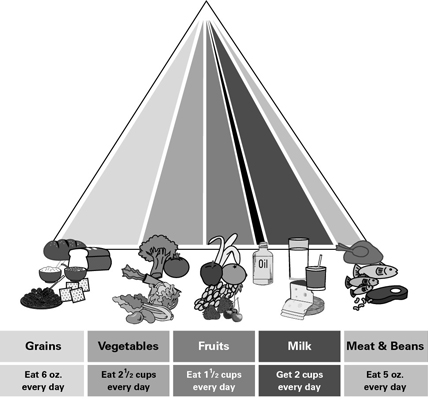You can tap into many resources when it comes to planning meals for your baby or toddler. Babies younger than 2 years old have some special dietary don’ts you need to know about. For recommendations on the types of foods young children should eat, you can consult the food pyramid compiled by the U.S. Department of Agriculture. You can make use of suggested shopping lists of perishable and non-perishable foods to keep on hand. And, when your young one is sick, what you feed them can help cure them.
>
>
Food Pyramid for Young Children
Gone is the old food pyramid you grew up with, but the new pyramid the U.S. Department of Agriculture (USDA) recommends you use to plan meals for babies and toddlers is a fantastic resource. The following food pyramid for feeding 2- to 8-year-olds offers general guidelines. You can get info tailored to your child’s needs at the USDA’s MyPyramid Web site.

The food pyramid doesn’t include guidelines for babies younger than 2 because their needs change so much.
>
>
>
Foods to Avoid during Baby’s First Year
When it comes to planning meals for your baby, all foods aren’t created equal. Be sure to steer clear of the common problem foods in the following list. They’re the ones that can cause serious allergic and intolerance reactions during the first year of your baby’s life!
| Citrus fruit | Nuts |
| Cow’s milk and milk products | Shellfish |
| Eggs | Strawberries |
| Honey | Wheat |
>
>
>
Helpful Foods for Common Childhood Ailments
When your child is sick, follow the advice of your doctor (of course). In addition, you can plan to feed your baby or toddler nourishing meals to promote a speedy recovery. Along with any medicine the doctor may prescribe, consider serving the following foods when your child (over age 1) isn’t feeling well:
For a cold: Chicken soup (the old standby)
For a fever: Oatmeal and juices
For a sore throat: Flavored gelatin and fruit smoothies
For a stomachache: Bananas, rice, apples, and toast (dry), also known as the B.R.A.T. diet
>
>
>
Staple Foods for Feeding Your Baby and Toddler
Grocery shopping for the ingredients for healthful meals for your baby or toddler isn’t the easiest task. The following list contains perishable and nonperishable foods you’ll want to have on hand, so you can take care of the essentials in one fell swoop.
Don’t serve the foods with stars to kids under age 1. For two stars, wait until age 2.
| Nonperishable foods | Nonperishable foods | Perishable foods | Perishable foods |
|---|---|---|---|
| Broth, reduced sodium, chicken or beef | Oil, olive and vegetable | American cheese, slices | Milk, whole (for children age 1 or older) |
| Cheerios | Pasta, assorted | Bread, whole wheat | Mozzarella cheese sticks (string cheese) |
| Cinnamon | Peanut butter** | Butter, not margarine | Mozzarella cheese, shredded |
| Flour, all purpose and whole wheat | Pepper | Cheddar cheese, shredded | Parmesan cheese, grated |
| Fruit, dried (chewy fruits are best, such as dried apricots) | Pizza sauce | Eggs | Soy sauce |
| Honey* | Raisins | English muffins | Tortillas, wheat or flour |
| Jelly or jam, low sugar | Rice cakes | Fruits, assorted and fresh, including apples, avocados, bananas, pears, strawberries*, tomatoes | Vegetables, assorted and fresh, including broccoli, carrots, lettuce, and squash (summer or winter varieties) |
| Maple syrup | Rice, brown | Ketchup | Yogurt, full fat and varied flavors |
| Mustard, dry ground | Rolled oats | Mayonnaise, full fat | |
| Nonstick cooking spray | Salt | ||
| Nuts, assorted* (For peanuts, wait until age 2.) | Sunflower seeds |
>
>
dummies
Source:http://www.dummies.com/how-to/content/baby-toddler-meals-for-dummies-cheat-sheet.html
No comments:
Post a Comment